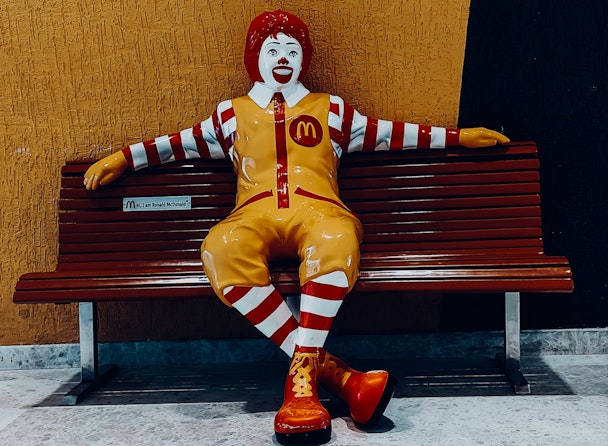B2B mascots are out of favor, but they still deliver great results
Nobody wants B2B mascots anymore, says Matt Kilgour at Earnest. Which is exactly why you should have one.

Ronald McDonald would likely not have made it through market research, says Matt Kilgour / Eshak Angell via Unsplash
At this juncture, I can only assume that you all hate mascots, lovely mascots. Furry, weird physiognomy, uncanny, goggle-eyed. You hate them and I want to know why.
Is it because you’re serious people, doing serious marketing, and you’re too good for fun? Is that it? Think you’re too good for fun? Fun! In this economy!?
Or is it because you’re still haunted - nervous, quaking – by the meat-hook grim specter of Clippy the MS Office paperclip? Is that it? The haunting? That little paperclip trying to help you, a nascent wordsmith, fumble your way through a letter?
Research shows mascots work
Something has to be responsible for the near four-fold decrease in the mascot market and not just in B2B – though this is where I feel the pain most acutely. According to research from System1:
“The use of fluent devices among entries to the IPA Effectiveness Awards has decreased from 41% in 1992 to just 12%. What’s more, the percentage of US ads using the tactic currently stands at just 4%."
What’s notable to me is that brands using mascots are, well, quite successful when it comes to brand, marketing, and making money. Aka, ‘the good stuff’.
Some notable B2B mascots include: The Geiko Gecko, Freddie the chimp from Mailchimp, Owly from Hootsuite, that little robot who I think is called Roger Mozbot for Moz, and Astro the space explorer for Salesforce.
And if you don’t believe me (fair enough, neither does my mum) you should consider listening again to the folks at System 1: “...campaigns using a fluent device are 37% more likely to increase market share than campaigns not using a fluent device; 27% more likely to increase customer gains; and 30% more likely to increase profit gains."
Ok, so we now know two things. First, mascots are in short supply. Second, they’re good for business. So O say again, where are all the mascots and why don’t you want them?
Advertisement
Time is a mascot's friend
I have a set of related theories. Firstly, focusing on short-term return on investment (ROI) can lead people to mistake weird ideas for dumb ones, killing them dead.
“What’s the ROI of a mascot?” is a question that’ll do some damage in a creative pitch. Return can take a long time.
I greatly enjoy the (hopefully not apocryphal story) about a brand marketer asking: “How do we get a brand icon like the Nike swoosh?” and being met with the rather droll response of “Well that’s easy, just pick something and stick with it for 45 years.”
There’s a lot of this logic with mascots. Most of the good ones have been around for a long time, and it's hard to imagine what the first few uncertain years would have felt like for a ‘giant white man made of tires’.
Not having a mascot is a safe bet
Thinking about what your brand wants to stand for in your audience's mind can be bafflingly hard. Codifying that into a mascot is harder still.
There’s no hard science to making a mascot. There’s lots of evidence as to their effectiveness, but there’s not exactly a roadmap to developing one. So I'm sympathetic to those just wanting to ignore the whole anthropomorphic mess and to focus more instead on knowable and ROI-oriented levers for growth.
Then there’s the performance-oriented marketers' desire to split-test everything to destruction. Research respondents will often want to smooth down rough edges. This can often be a good thing but is frequently lethal to boldness.
If McDonald’s had run split tests on Ronald, you’d have had a less creepy clown I'm sure. An entire generation could have avoided a latent association between monosodium glutamate and coulrophobia. But I'm not convinced you’d have had a better-quality mascot.
How many months would have been spent debating whether Camel cigarettes’ eponymous ungulate was a dromedary or a bactrian camel? (Remember - a dromedary has one hump, a bactrian has two: just think of a capital 'D' and a capital 'B' for a handy guide.)
Not having a mascot is a safe bet. But as Earnest CEO Chris Wilson has often told me, sometimes safe can be dangerous. No one seems to want a mascot. Which, from where I'm sitting, means it's the right time to get working on one.
Content by The Drum Network member:

Earnest
Earnest is the award-winning B2B marketing agency that’s chasing out the humdrum in London and New York.
Why is B2B treated like the poor cousin to B2C?...

